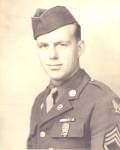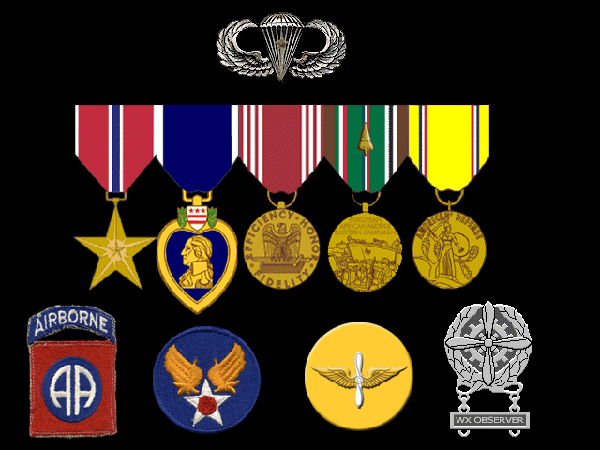|
Staff Sergeant Robert A. Dodson enlisted in the
Army in August 1941 and trained as a weather observer at New Orleans
Army Bomber Base in September 1941. In April 1944, Sergeant Dodson
was assigned to the 21st Weather Squadron in Ascot, England and a month
later he volunteered jump school training. As his paperwork was
being processed, the jump school was shut down in preparation for
"D-Day". Undaunted, Sergeant Dodson and his commanding officer
convinced the 82nd Airborne Division, located at Manchester, England, to
make room for one more soldier. Sergeant Dodson became a member of
an Air Support Party from Ninth Air Force attached to Headquarters, 82nd
Airborne Division, which consisted of an Officer in Charge, five
communications men who acted as forward air controllers, a driver, and a
weather observer, equipped with a half-track and a "veep" (radio
equipped jeep). Sergeant Dodson received a minimum of
mock-up training before making his
first and only jump.
 At 0230hrs on 6 June 1944, Sergeant Dodson jumped with Force "A" of the
82nd Airborne Division commanded by Brigadier General James M. Gavin.
The sky was moonlit and practically clear when he landed about a mile
northeast of St. Mere Eglise, France in a field where cattle were
grazing. One other man had landed in the same field with him and
the two of them set out at once toward the head of the stick, in spite
of a knee injury Sergeant Dodson sustained during the jump. As
they proceeded they picked up eight other members of their outfit one at
a time. Things were progressing according to schedule and they had
yet to make contact with the enemy. They found three injured men
along the way, gave them first aid, and continued on. Along the
way they recovered their equipment which they unpacked, selected a VHF
radio, and camouflaged the rest of the equipment in a hedgerow before
finally linking up with the command post which had relocated to St. Mere
Eglise.
At 0230hrs on 6 June 1944, Sergeant Dodson jumped with Force "A" of the
82nd Airborne Division commanded by Brigadier General James M. Gavin.
The sky was moonlit and practically clear when he landed about a mile
northeast of St. Mere Eglise, France in a field where cattle were
grazing. One other man had landed in the same field with him and
the two of them set out at once toward the head of the stick, in spite
of a knee injury Sergeant Dodson sustained during the jump. As
they proceeded they picked up eight other members of their outfit one at
a time. Things were progressing according to schedule and they had
yet to make contact with the enemy. They found three injured men
along the way, gave them first aid, and continued on. Along the
way they recovered their equipment which they unpacked, selected a VHF
radio, and camouflaged the rest of the equipment in a hedgerow before
finally linking up with the command post which had relocated to St. Mere
Eglise.
The Germans
counterattacked, and during thirty-six hours all members of the Air
Support Party acted as riflemen. When the siege was lifted,
Sergeant Dodson began his weather observing duties. Each hour he
sent by radio the present weather, wind direction and speed, visibility,
ceiling and cloud heights, temperature, and dew point. For the
last elements he was equipped with a shielded psychrometer and
psychometric tables, while all other elements were determined visually.
This work continued until 21 June, when Sergeant Dodson was evacuated to
the hospital at Bouteville for treatment on the knee he injured during
the jump. He later returned to his unit, which returned to England
when it was relieved on 13 July. Sergeant Dodson, who made his
first trip to France during the war with a parachute as a weather
observer with the 82nd Airborne Division, returned to France with the
headquarters of Ninth Air Force and the 21st Weather Squadron, serving
out the rest of the war as chief dispatcher at the motor pool. He
left the service in September 1945.
Sergeant Dodson's military decorations include
the Bronze Star Medal, Purple Heart, Europe-Africa-Middle East
Campaign medal with 4 bronze service stars (for the Normandy, Northern
France, Rhineland and Central Europe campaigns), American Defense
Service Medal, and Distinguished Unit Citation. The Air Weather
Service recognized Sergeant Dodson's World War II service in July 1987
by naming its Specialized Support Award in his honor.

Simmons Weather
Information above is from
this link
|



